#herrerasaurid
Note
did any non-theropod dinosaurs become carnivores or did theropods hold sole monopoly of land predator niches?
As far as we know, none of the major non-theropod lineages became carnivorous after specialising into herbivory! Only thing I can think of is herrerasaurids, which are technically not theropods as they are basal saurischians that don't belong to theropoda or sauropodomorpha. Like this guy, Gnathovorax, who can only be described as looking like Dinosaur Beta Version 1.0:

Like theropods, herrerasaurids probably specialised into carnivory from an omnivorous basal dinosaurian ancestor. However, no dinosaur group that became herbivores ever re-specialised as carnivores that we know of. Without a doubt most herbivorous dinosaurs ate meat on occasion just like herbivores today, but that's very different to obligate carnivory.
On the other hand, there were plenty of non dinosaur terrestrial predators! Among the reptiles, there were predatory terrestrial crocodiles (notosuchians, including Baurusuchus), as well as large carnivorous lizards (Palaeosaniwa and Asprosaurus). There were also predatory mammals such as Repenomamus that at least occasionally ate dinosaurs!
212 notes
·
View notes
Text

A little Herrerasaurus bust I did
#art#my art#digital art#paleoart#paleontology#palaeoblr#archosaurs#herrerasaurids#herrerasaurus#queue
23 notes
·
View notes
Text
Round One: Gnathovorax vs Mbiresaurus

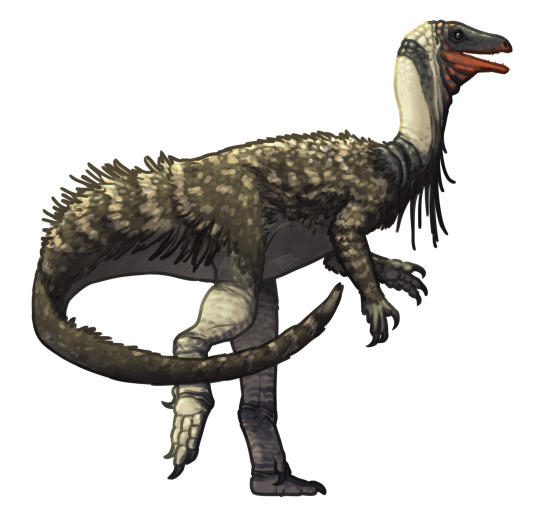
Factfiles:
Gnathovorax cabreirai

Artwork by @i-draws-dinosaurs, written by @i-draws-dinosaurs
Name meaning: Cabreira’s devouring jaw (in honour of the discoverer Dr. Sérgio Furtado Cabreira)
Time: 233.23 million years ago (Carnian stage of the Late Triassic)
Location: Santa Maria Formation, Brazil
Gnathovorax is a herrerasaurid dinosaur named in 2019, and we shoved it into the sauropodomorph section just so that we would have somewhere to put it. It’s known from an impressively complete skeleton with almost all bone elements represented, including a beautiful skull! It’s also the first herrerasaurid named in a long time, and its discovery has helped reignite the study of this weird group of guys.
Where herrerasauridae fits into dinosauria is, simply put, A Mess. They had been considered the earliest theropods for decades, but more recent work like the kinda still controversial ornithoscelida hypothesis placed them as the sister group of sauropodomorphs, and further analyses even placed them outside of dinosaurs entirely! Thankfully, Gnathovorax seems to have helped resolve some of those issues with a new-new analysis of herrerasaurid relationships, that puts them as basal saurischians, neither sauropodomorphs or theropods.
Mbiresaurus raathi

Artwork by @i-draws-dinosaurs, written by @i-draws-dinosaurs
Name meaning: Raath’s reptile from Mbire (after the Mbire district of Zimbabwe, and in honour of palaeontologist and discoverer Michael Raath)
Time: ~ 230 million years ago (Carnian stage of the Late Triassic)
Location: Pebbly Arkose Formation, Zimbabwe
There was once a time… before titanosaurs… before diplodocids… before any sauropod… when sauropodomorphs were simply Just Some Little Guy. And that is where Mbiresaurus, oldest African dinosaur ever found, comes in!
Mbiresaurus was named in 2022 from Zimbabwe, and is the only dinosaur yet named from the Pebbly Arkose formation. It’s known from a beautifully complete skeleton that has all the features of a classic Early Dinosaur. It is small, has long gangly legs and arms, and a lil head with vaguely pointy kinda multipurpose teeth. The fact that all the wild diversity and enormous size of the sauropods came out of something like this is hard to imagine, but evolutionarily step by step these little scampery dudes would work their way up!
DMM Round One Masterpost
#dmm#dinosaur march madness#dmm round one#dmm: rising stars#palaeoblr#dinosaurs#paleontology#bracket#march madness#polls#gnathovorax#mbiresaurus
112 notes
·
View notes
Text
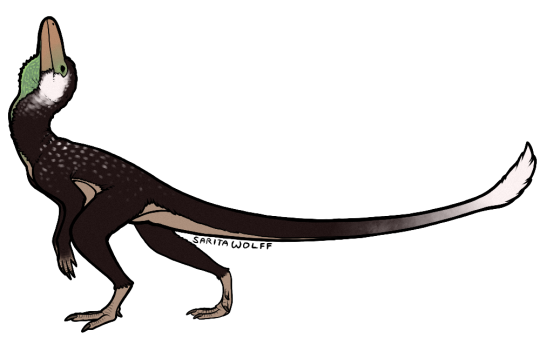
#Archovember Day 26 - Ixalerpeton polesinensis
The Triassic lagerpetids were once thought to be early dinosauromorphs, but recent fossil evidence suggest that they were actually pterosauromorphs… either closely related to pterosaurs or even ancestral to them! Ixalerpeton polesinensis was a lagerpetid from Late Triassic Brazil, a locale that would eventually become a hotspot for pterosaurs. Like other lagerpetids, it had long hind legs with well-developed muscles, but it lacked the neural spines that suggest hopping locomotion as in Lagerpeton. It was small and agile, likely using its long legs to chase and leap after insects.
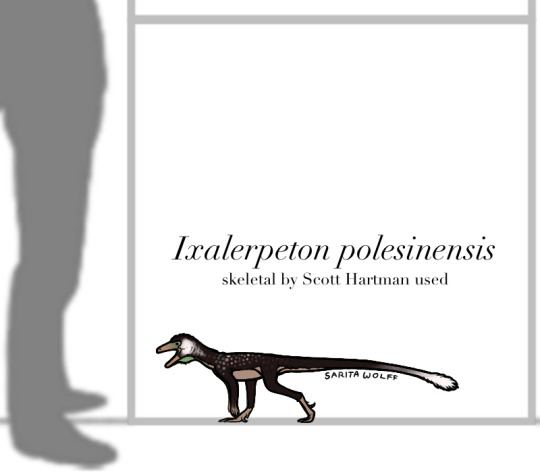
In the Upper Santa Maria Formation, Ixalerpeton would have had to watch out for large predatory pseudosuchians like Rauisuchus and herrerasaurids like Staurikosaurus and Gnathovorax. It also lived alongside early aetosaurs Aetobarbakinoides and Aetosauroides, silesaurs like Amanasaurus, and basal sauropodomorphs Buriolestes and Saturnalia. There were also a variety of cynodonts, like Gomphodontosuchus and Prozostrodon, and the temnospondyl amphibian Compsocerops.
#my art#SaritaDrawsPalaeo#Ixalerpeton polesinensis#Ixalerpeton#lagerpetid#pterosauromorphs#archosaurs#archosauromorphs#reptiles#Archovember#Archovember2023
18 notes
·
View notes
Text
Dinofact #102
Tawa hallae possesses attributes that can be assosciated with different dinosaur taxa. For example, its skull morphology resembles that of coelophysoids, and its ilium approximates that of a herrerasaurid. It also possesses an adaption in its neck vertebrae which supports the idea that cervical air sacs predate Netheropoda and may be ancestral in Saurischians.
Source: Wikipedia
#dinosaur#dinosaurs#paleontology#tawa#tawa hallae#taxonomy#morphology#netheropoda#saurischia#saurischian#saurischians#fun facts#trivia#dinosaur trivia#dinosaur fun facts#7th#december#2022#december 7th#december 2022#december 7th 2022
15 notes
·
View notes
Text
Qual'è il più antico dinosauro mai trovato?
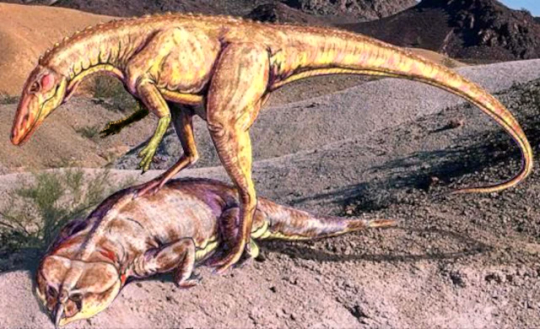
Scoperto il più antico dinosauro africano. Dimostra che il clima condizionò la diffusione dei primi dinosauri. Scoperto in Zimbabwe il più antico dinosauro africano, vissuto circa 230 milioni di anni fa: chiamato Mbiresaurus raathi, era un parente dei sauropodi caratterizzato da un lungo collo.
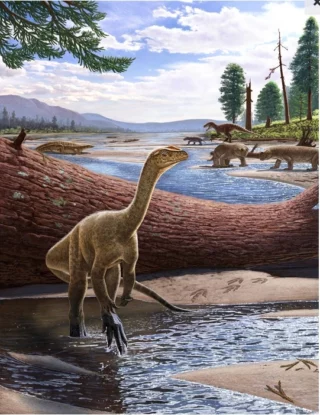
Ricostruzione artistica del più antico dinosauro africano, Mbiresaurus raathi (fonte: A. Atuchin)
Alto circa un metro, pesava meno di 30 chili, aveva una testa piccola, denti triangolari seghettati e si muoveva su due zampe. Il suo fossile, quasi completo, colma una lacuna geografica nella documentazione fossile dei dinosauri più antichi, dimostrando che la loro dispersione è stata condizionata da fattori climatici. Lo indica lo studio pubblicato su Nature da un gruppo internazionale di paleontologi guidati dal Virginia Tech.
Il fossile di Mbiresaurus raathi è stato trovato insieme ai resti di altri animali del Tardo Triassico, come un dinosauro herrerasauride, antichi parenti dei mammiferi come il cinodonte, rettili corazzati come gli aetosauri e i rettili rincosauri. Simili depositi di fossili della stessa epoca erano già stati trovati in Sud America e in India.
"I dinosauri più antichi vengono più o meno dalle stesse antiche latitudini lungo la cintura climatica temperata meridionale che si trovava a circa 50 gradi sud", spiega il ricercatore Christopher Griffin. Proprio per questo motivo, il suo team ha deciso di condurre degli scavi nel nord dello Zimbabwe, nelle aree che rientravano in quella antica fascia climatica, colmando così il gap tra il sud del Brasile e l'India.
Per verificare l'ipotesi che i primi dinosauri fossero davvero confinati da vincoli climatici nel sud dell'antico supercontinente Pangea, i ricercatori hanno condotto uno studio statistico sull'albero evolutivo dei dinosauri, scoprendo così che la loro dispersione verso nord è avvenuta in corrispondenza di un periodo di forte umidità a livello globale (Evento Pluviale Carnico) che ha rotto le 'barriere' climatiche.
Read the full article
#africa#africano#alberoevolutivo#clima#dinosauro#EventoPluvialeCarnico#evoluzione#fossilefossili#Mbiresaurusraathi#paleontologia#Zimbabwe
0 notes
Photo
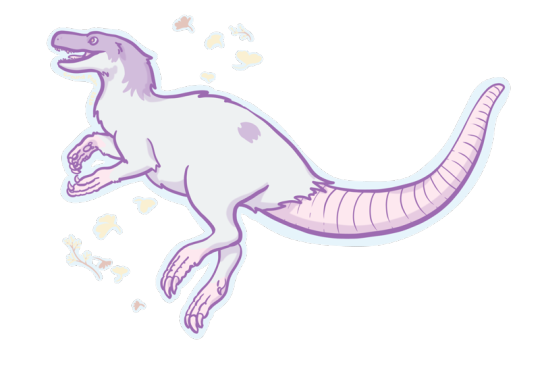
What I was supposed to do: Wash the other two thrids of the dishes
What I am actually doing: WHY NOT A RATTOSAUR
Alternate fursona, based on my ratsona and a Gnathovorax - if you didn’t see the fossil OMG WHAT ARE YOU WAITING. It. Is. Beautiful. Allright, must say that I love herrerasaurids... and I literally almost cried with the the announce and the images of the described fossil :’).
EDIT: Yes, she loves Frozen II xD
#azdrawing#illustration#science#paleoart#paleoblr#gnathovorax#dinosaur#herrerasaurid#triassic#late triassic#paleo#fancy rat#fursona#furry#furry art#feral furry#furry oc#hybrid fursona#my art
68 notes
·
View notes
Text
Episode 283: Phil Tippett on animating Jurassic Park
I Know Dino Podcast Episode 283: Phil Tippett from @Tippett_Studio on animating Jurassic Park. We also cover sauropod posture: Did they hold their heads up high or near the ground? Plus #dinosaur of the day Staurikosaurus
Episode 283 is all about Staurikosaurus, a small Triassic carnivore from what is now Brazil.
Interview with Phil Tippett, the founder and Chief Creative Officer of Tippett Studio. He is a two-time Oscar and Emmy award winner for his visual effects work, for the movies Jurassic Park and Return of the Jedi and the documentary Dinosaur! and the TV film Caravan of Courage: An Ewok Adventure. His…
View On WordPress
#animation#animatronic#Brazil#Carnivore#Cretaceous#Dino Evil 3#dinosaur#dinosaur of the day#Dinosaur!#dinosaurs#Early#herrerasaurid#i know dino#Jurassic#jurassic park#jurassic world#king kong#Late#Mad God#Mesozoic#mod#name#Phil Tippett#podcast#posture#Prehistoric Beast#Resident Evil 3#rex#sauropod#Spinophorosaurus
8 notes
·
View notes
Text
Daily Dinosaur Facts: Day 3

Herrerasaurus wasn’t just one of the earliest dinosaurs, it was also one of the biggest theropods in the Triassic.
Image Source
#Daily#Dinosaur#Dinosaurs#Fact#Facts#dailydinosaurfact#DailyDinosaurFacts#Day3#Herrerasaurus#Argentina#Argentinian#South#SouthAmerica#SouthAmerican#America#American#Triassic#LateTriassic#Herrerasauridae#Herrerasaurid#Theropoda#Theropod#Theropods#Saurischian#Saurischia
4 notes
·
View notes
Photo

Lophostropheus airelensis
Late Triassic – Early Jurassic (200 Ma)
Things are scary lately, but I hope everyone is doing well. In these stressful times I've taken to drawing dinosaurs on my computer to ease my nerves. Originally, I set out to draw a dromaeosaur, but it somehow ended up a Lophostropheus. But don't worry, I'll do some dromaeosaurs once I'm confident I can draw them as beautifully as they deserve.
Lophostropheus was found in the Triassic-Jurassic boundary in France. Few animals are known to have lived from the end of the Triassic and into the early Jurassic, because this transition was marked by a mass extinction caused, at least in part, by the breaking up of Pangea. Mass extinctions are often recognized because of sudden, dramatic turnovers in the fossil record. We don't expect to see individual genera or species surviving the events, and this is especially true for dinosaurs of the T-J Extinction, which disproportionately impacted terrestrial life. Of course, we know species had to survive these times of hardship, but thanks to the spottiness of the fossil record it's not often we get to see it. I'm realizing this is starting to sound kind of doom and gloom in today's context, so let's talk more about Lophostropheus.
This is a member of the coelophysoids, one of the first prolific groups of theropods. Coelophysoids were, despite being relatively short-lived, a sign of things to come. They were lankier and had smaller heads compared to the more robust earlier theropods, like Herrerasaurids. They also have a lot of traits we associate with later theropods, showing that these features appeared quickly once dinosaurs established themselves. Many were small and slender like the group's namesake, Coelophysis, but some later members, like this one here, got bigger. Lophostropheus isn't known from the best remains, but could have been up to 3 meters (10 feet) long. That may not sound like much, but this put it among the largest carnivorous dinosaurs of the time.
Because Lophostropheus is known from fragmentary remains, it's difficult to say much definitively about its behavior or ecology, and I'll admittedly be inferring based on similar features in related dinosaurs. So, take the next section as you will, but know I'm trying to avoid speculating too hard. As a science communicator, the last thing I want to do is mislead.
Lophostropheus probably preyed on large herbivores, including early sauropodomorphs like Plateosaurus, and may have chased down smaller, more agile animals as well. The function of its crest is unclear. It was too fragile to be used as a weapon or armor, which, to be fair, would be kind of far-fetched anyway. It may have been used for intraspecies interactions, as a mating display or as an intimidation tool against rivals.
It was originally considered a species of the closely-related Liliensternus, but was assigned to its own genus in 2007. In fact, after deciding not to draw a dromaeosaur, I wanted to draw Liliensternus, but found out it didn't have that Dilophosaurus-like crest it's always depicted with. BUT I learned a very similar dinosaur who did have a crest existed, and thus, Lophostropheus. I'm wondering if the trend of Liliensternus being depicted with a crest was caused by this dinosaur being associated with it, but I haven't found anything confirming it.
That's about what I have to say about Lophostropheus. I didn't really know it existed until I drew it, but the Triassic/early Jurassic is one of my favorite time periods of the Mesozoic. It's fascinating how quickly dinosaurs established a foothold, and then how quickly they flourished once they had the space. Even when they looked kind of the same, dinosaurs were starting to show the traits that would become markers of their diversity.
SOURCES
Ezcurra & Cuny 2007 – The coelophysoid Lophostropheus airelensis (Abstract only, I couldn’t access the full paper)
Olsen, Shubin, & Anders 1987 – New Early Jurassic Tetrapod Assemblages Constrain Triassic-Jurassic Tetrapod Extinction Event
******************************************************************************
Buy me a Ko-fi, if you’d like!
#lophostropheus#theropods#dinosaurs#reptiles#triassic#jurassic#mesozoic#paleontology#palaeontology#paleoart#palaeoart#paleoblr#palaeoblr#prehistoric
25 notes
·
View notes
Text
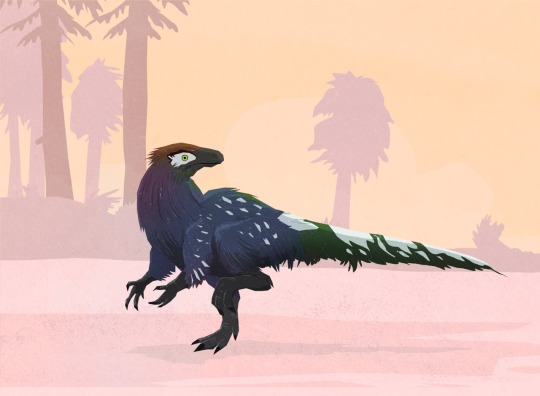
Chindesaurus bryansmalli, an early herrerasaurid dinosaur from the Late Triassic (Carnian-Norian) period in what is now the Southwestern United States. It was a small, bipedal carnivore with a long tail and a length estimated at 2 to 2,3 meters (6.6 to 7.5 feet).
For prints and stuff, check: https://www.stavrosillustration.se
189 notes
·
View notes
Photo

New dinosaur alert! Presenting Mbiresaurus raathi
Image ID: A digital illustration of the early sauropodomorph dinosaur Mbiresaurus. It is a slender, two-legged dinosaur with a long neck and tail and a body covered in fluffy feathers. The feathers are brown with lighter speckles that turn into stripes on the tail. The head and neck are wrinkled and featherless except for a few long feathers that hang from the base of the neck. The head and neck are coloured with patches of black and white, and an orange lower jaw. The Mbiresaurus is posed in a rough three-quarter view, facing to the right and away from the viewer. The neck is upright and alert, the mouth is slightly open, one foot is raised off the ground and the tail is curved around in front of its legs. End ID.
A newly-described species from Zimbabwe, Mbiresaurus is now the oldest named dinosaur species from Africa! It’s an early sauropodomorph, related to dinosaurs like Eoraptor and Buriolestes, and was probably an omnivore.
Mbiresaurus comes from a new fossil site in Zimbabwe, which contains a whole lot of other species that have yet to be described, including a herrerasaurid, which I’ve represented in this size diagram with Staurikosaurus.

Image ID: A size chart showing Mbiresaurus and the early carnivorous dinosaur Staurikosaurus next to a light grey silhouette of a person. The Mbiresaurus’ head is level with the person’s upper thigh, and the Staurikosaurus’ head comes to approximately waist height. End ID.
The formation also includes a number of synapsid species, a rhynchosaur, and an aetosaur, a group of armoured herbivorous crocodile relatives that had never been found in southern Africa before! When combined together into Pangaea, the location of the fossil site matches the latitude of other Late Triassic early dinosaur sites, suggesting that dinosaurs and other Late Triassic species initially migrated across a similar climatic band that would eventually become South America and southern Africa.
#dinosaurs#paleoart#paleontology#new dinosaur#palaeoblr#mbiresaurus#sauropodomorph#triassic#fossils#prehistoric
593 notes
·
View notes
Photo
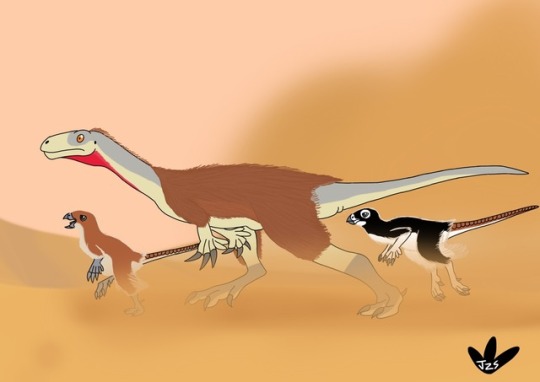
Desert dwelled #phytodinosauria (Anchisaurus and basal Ornithischia) are escaping by running from huge sandstorm. As you can see, phytodinosaur is all about long forgotten family tree for both basal Sauropodomorpha and Ornithischia, it was all started with November 1, 2017. And especially the reason why I add anchisaur some feather-like filaments it because these prosauropod (later known as basal sauropodomorpha) are more closely related to Ornithischia than to Herrerasaurid of the Saurischia as previously thought and especially to theropoda.
#anchisaurus#sauropodomorpha#prosauropod#ornithischia#phytodinosauria#dinovember#drawdinovember#dinosaur#dinosauria#paleoart#my art
5 notes
·
View notes
Text
Saturnalia tupiniquim

By Ripley Cook
Etymology: Named for the Roman festival of Saturn
First Described By: Langer et al., 1999
Classification: Dinosauromorpha, Dinosauriformes, Dracohors, Dinosauria, Saurischia, Eusaurischia, Sauropodomorpha, Saturnaliidae
Status: Extinct
Time and Place: 233.23 million years ago, in the Carnian of the Late Triassic

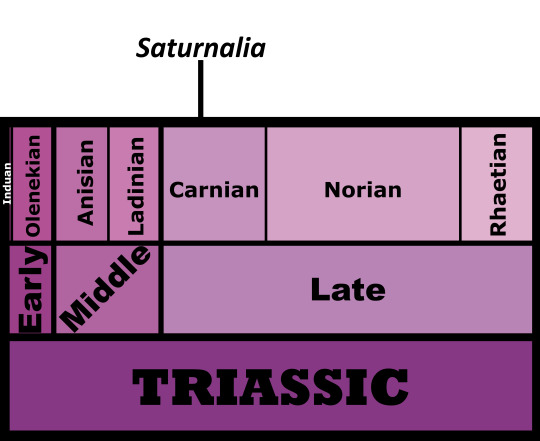
Saturnalia is known from the Alemoa Member of the Santa Maria Formation - it is also possibly known from Zimbabwe, but this assignment is dubious

Physical Description: Saturnalia was probably a very early Prosauropod - aka, those dinosaurs that were more closely related to the large and famous Sauropods than any other kind of dinosaur (the official name for these dinosaurs being Sauropodomorphs). As an early Prosauropod, then, Saturnalia didn’t look very much different from other early dinosaurs - it was small, fluffy, squat, and bipedal. It was so much like other dinosaurs that it is often classified outside of Sauropodomorpha proper - and that continues to be a source of debate for these dinosaurs. In fact, according to some, it’s an early theropod!! More work is clearly needed, but regardless, Saturnalia was about 1.5 meters long and no more than a meter tall. It had a somewhat long neck - but no longer than other early dinosaurs, certainly not proper sauropodomorph length - and a small head. It had short arms, somewhat short legs, and a short tail as well. It was very slight, and had a skull like that of prosauropods, though its legs were more like those of theropods. Overall - a very average looking early dinosaur, and certainly very similar to the early Sauropodomorphs and the early Theropods of the time.
Diet: Saturnalia probably was an omnivore, feeding on both meat and plant food, at low levels of vegetation and mainly focusing on very small animals. Though it is also possible that it was a carnivore.

By Rex Chen
Behavior: Saturnalia, regardless of its affinity, would have been a very skittish animal - avoiding predators in its environment at all costs, and running about on its tip-toes in order to avoid danger. It was probably at least somewhat social, given multiple skeletons have been found of it, though of course we cannot be certain of such. Regardless, it would have spent a large portion of its day foraging on food, looking around for leaves to strip from branches and small animals to catch in its mouth. It would have probably taken care of its young, and may have formed family groups to do so. The long-ish neck of Saturnalia would have allowed it to reach deeper into the plantlife in order to grab food out of reach.
Ecosystem: The Santa Maria Formation is a hotspot of early dinosaur diversity, showcasing especially the initial explosion of Sauropodomorphs after dinosaurs first appeared. This was an extensive floodplain environment, filled with seed ferns and conifers, giving Saturnalia good amounts of cover to protect it from other creatures. This was important, because Saturnalia was far from alone in its home. Here, there were predatory dinosaurs, such as the Herrerasaurid Staurikosaurus and the prosauropod Buriolestes; mystery dinosaurs like Nhandumirim; other early prosauropods like Pampadromaeus and Bagualosaurus; the Lagerpetid Ixalerpeton; the weird Aphanosaur Spondylosoma; large Loricatan predators like Rauisuchus, Procerosuchus, Prestosuchus, Decuriasuchus, and Dagasuchus; large herbivorous Aetosaurs such as Aetobarbakinoides, Aetosauroides, and Polesinesuchus; rhynchosaurs like Hyperodapedon and Brasinorhynchus; mystery reptiles like Barberenasuchus; Proterochampsids like Cerritosaurus, Chanaresuchus, Proterochampsa, and Rhadinosuchus; Erpetosuchids like Pagosvnator; and plenty of synapsids such s Chiniquodon, Candelariodon, Exaeretodon, Protuberum, Santacruzodon, and Trucidocynodon. In short - an extremely diverse and flourishing environment, showcasing the true weirdness that was the Triassic period.
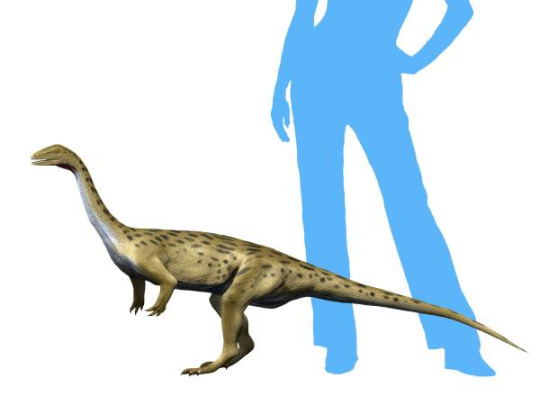
By Nobu Tamura, CC BY-SA 4.0
Other: Was Saturnalia a theropod or a prosauropod? The jury is still out. Its back half looks much like that of a theropod, but its head? Similar to prosauropods. The most recent analysis has it as a sauropodomorph - probably - but people still debate, and arguments continue to go on. It is often considered a part of a bigger group of dinosaurs including animals like Guaibasaurus, but some of these animals in recent studies have been found as prosauropods, and some as theropods, breaking up the group. So, the scientists continue to debate, and the exact nature of Saturnalia remains a mystery - but, for now, we can probably still call it a Sauropodomorph, along with Pampadromaeus.
~ By Meig Dickson
Sources Under the Cut
Abdala, F., & A. M. Ribeiro (2003). "A new traversodontid cynodont from the Santa Maria Formation (Ladinian-Carnian) of southern Brazil, with a phylogenetic analysis of Gondwanan traversodontids". Zoological Journal of the Linnean Society. 139 (4): 529–545.
Apaldetti, C., R. N. Martinez, O. A. Alcober and D. Pol. 2011. A new basal sauropodomorph (Dinosauria: Saurischia) from Quebrada del Barro Formation (Marayes-El Carrizal Basin), Northwestern Argentina. PLoS ONE 6(11):e26964:1-19
Aurélio, M., G. França; Jorge Ferigolo; Max C. Langer (2011). "Associated skeletons of a new middle Triassic "Rauisuchia" from Brazil". Naturwissenschaften. 98 (5): 389–395.
Barberena, MC (1978). "A huge tecodont skull from the Triassic of Brazil". Pesquisas Em Geociências. 9 (9): 62–75.
Bonaparte, J.F.; Ferigolo, J.; Ribeiro, A.M. (1999). "A new early Late Triassic saurischian dinosaur from Rio Grandedo Sul State, Brazil." Proceedings of the second Gondwanan Dinosaurs symposium". National Science Museum Monographs, Tokyo. 15: 89–109.
Bonaparte, J.F.; Brea, G.; Schultz, C.L.; Martinelli, A.G. (2007). "A new specimen of Guaibasaurus candelariensis (basal Saurischia) from the Late Triassic Caturrita Formation of southern Brazil". Historical Biology. 19 (1): 73–82.
Brea, G., J. F. Bonaparte, C. L. Schultz and A. G. Martinelli. 2005. A new specimen of Guaibasaurus candelariensis (basal Saurischia) from the Late Triassic Caturrita Formation of southern Brazil. In A. W. A.
Cabreira, Sergio F.; Cesar L. Schultz; Jonathas S. Bittencourt; Marina B. Soares; Daniel C. Fortier; Lúcio R. Silva; Max C. Langer (2011). "New stem-sauropodomorph (Dinosauria, Saurischia) from the Triassic of Brazil". Naturwissenschaften. 98 (12): 1035–1040.
Cabreira, S.F.; Kellner, A.W.A.; Dias-da-Silva, S.; da Silva, L.R.; Bronzati, M.; de Almeida Marsola, J.C.; Müller, R.T.; de Souza Bittencourt, J.; Batista, B.J.; Raugust, T.; Carrilho, R.; Brodt, A.; Langer, M.C. (2016). "A Unique Late Triassic Dinosauromorph Assemblage Reveals Dinosaur Ancestral Anatomy and Diet". Current Biology. 26: 3090–3095.
Colbert, EH (1970). "A saurischian dinosaur from the Triassic of Brazil". American Museum Novitates. 2045: 1–39.
Da-Rosa, Átila A. S. (2015-08-01). "Geological context of the dinosauriform-bearing outcrops from the Triassic of Southern Brazil". Journal of South American Earth Sciences. 61: 108–119.
Da-Rosa, Átila Augusto Stock; Paes-Neto, Voltaire Dutra; Schultz, Cesar Leandro; Desojo, Julia Brenda; Brust, Ana Carolina Biacchi (2018-08-15). "Osteology of the first skull of Aetosauroides scagliai Casamiquela 1960 (Archosauria: Aetosauria) from the Upper Triassic of southern Brazil (Hyperodapedon Assemblage Zone) and its phylogenetic importance". PLOS ONE. 13 (8): e0201450.
De Oliveira, T. V., Cesar Leandro Schultz, Marina Bento Soares and Carlos Nunes Rodrigues (2011). "A new carnivorous cynodont (Synapsida, Therapsida) from the Brazilian Middle Triassic (Santa Maria Formation): Candelariodon barberenai gen. et sp. nov". Zootaxa. 3027: 19–28.
Delsate, D., and M. D. Ezcurra. 2014. The first Early Jurassic (late Hettangian) theropod dinosaur remains from the Grand Duchy of Luxembourg. Geological Belgica 17(2):175-181
Desojo, J. B., Martin D. Ezcurra and Edio E. Kischlat (2012). "A new aetosaur genus (Archosauria: Pseudosuchia) from the early Late Triassic of southern Brazil" (PDF). Zootaxa. 3166: 1–33. ISSN 1175-5334
Desojo, Julia B.; Trotteyn, M. Jimena; Hechenleitner, E. Martín; Taborda, Jeremías R. A.; Miguel Ezpeleta; von Baczko, M. Belén; Rocher, Sebastián; Martinelli, Agustín G.; Fiorelli, Lucas E. (October 2017). "Deep faunistic turnovers preceded the rise of dinosaurs in southwestern Pangaea". Nature Ecology & Evolution. 1 (10): 1477–1483.
Dias-Da-Silva, Sérgio; Müller, Rodrigo T.; Garcia, Maurício S. (2019-07-04). "On the taxonomic status of Teyuwasu barberenai Kischlat, 1999 (Archosauria: Dinosauriformes), a challenging taxon from the Upper Triassic of southern Brazil". Zootaxa. 4629 (1): 146–150.
Ezcurra, M. D. 2010. A new early dinosaur (Saurischia: Sauropodomorpha) from the Late Triassic of Argentina: a reassessment of dinosaur origin and phylogeny. Journal of Systematic Palaeontology 8:371-425
Ezcurra, MD (2012). "Comments on the Taxonomic Diversity andPaleobiogeography of the Earliest Known Dinosaur Assemblages (Late Carnian-Earliest Norian)". Historia Natural. 2.
Ezcurra, Martín D.; Desojo, Julia B.; Rauhut, Oliver W.M. (August 2015). "Redescription and Phylogenetic Relationships of the Proterochampsid Rhadinosuchus gracilis (Diapsida: Archosauriformes) from the Early Late Triassic of Southern Brazil". Ameghiniana. 52 (4): 391–417.
Flávio A. Pretto; Max C. Langer; Cesar L. Schultz (2018). "A new dinosaur (Saurischia: Sauropodomorpha) from the Late Triassic of Brazil provides insights on the evolution of sauropodomorph body plan". Zoological Journal of the Linnean Society. in press.
Galton, P. M., and P. Upchurch. 2004. Prosauropoda. In D. B. Weishampel, P. Dodson, and H. Osmolska (eds.), The Dinosauria (second edition). University of California Press, Berkeley 232-258
Galton, P. M. 2007. Notes on the remains of archosaurian reptiles, mostly basal sauropodomorph dinosaurs, from the 1834 fissure fill (Rhaetian, Upper Triassic) at Clifton in Bristol, southwest England. Revue de Paléobiologie 26(2):505-591
Galton, P. M., A. M. Yates, and D. M. Kermack. 2007. Pantydraco n. gen. for Thecodontosaurus caducus Yates, 2003, a basal sauropodomorph dinosaur from the Upper Triassic or Lower Jurassic of South Wales, UK. Neues Jahrbuch für Geologie und Paläontologie Abhandlungen 243(1):119-125
Griffin, C. T., and S. J. Nesbitt. 2016. The femoral ontogeny and long bone histology of the Middle Triassic (?late Anisian) dinosauriform Asilisaurus kongwe and implications for the growth of early dinosaurs. Journal of Vertebrate Paleontology 36(3):e1111224:1-22
Gower, D. J. (2000). "Rauisuchian archosaurs (Reptilia:Diapsida): An overview" (PDF). Neues Jahrbuch für Geologie und Paläontologie, Abhandlungen. 218 (3): 447–488
Harris, S. K., A. B. Heckert, S. G. Lucas and A. P. Hunt. 2002. The oldest North American prosauropod, from the Upper Triassic Tecovas Formation of the Chinle Group (Adamanian: latest Carnian), west Texas. In A. B. Heckert & S. G. Lucas (eds.), Upper Triassic Stratigraphy and Paleontology. New Mexico Museum of Natural History and Science Bulletin 21:249-252
Horn, B. L. D.; Melo, T. M.; Schultz, C. L.; Philipp, R. P.; Kloss, H. P.; Goldberg, K. (2014-11-01). "A new third-order sequence stratigraphic framework applied to the Triassic of the Paraná Basin, Rio Grande do Sul, Brazil, based on structural, stratigraphic and paleontological data". Journal of South American Earth Sciences. 55: 123–132.
Irmis, R. B., and F. Knoll. 2008. New ornithischian dinosaur material from the Lower Jurassic Lufeng Formation of China. Neues Jahrbuch für Geologie und Paläontologie Abhandlungen 247(1):117-128
Kellner, D. D. R. Henriques, and T. Rodrigues (eds.), II Congresso Latino-Americano de Paleontologia de Vertebrados, Boletim de Resumos. Museum Nacional/UFRJ, Rio de Janeiro 55-56
Kischlat, EE (1999). "A new dinosaurian "rescued" from the Brazilian Triassic: Teyuwasu barbarenai, new taxon". Paleontologia Em Destaque, Boletim Informativo da Sociedade Brasileira de Paleontologia. 14 (26): 58.
Lacerda, M. B.; Schultz, C. L.; Bertoni-Machado, C. (2015). "First 'Rauisuchian' archosaur (Pseudosuchia, Loricata) for the Middle Triassic Santacruzodon Assemblage Zone (Santa Maria Supersequence), Rio Grande do Sul State, Brazil". PLoS ONE. 10 (2): e0118563. PMC 4340915 Freely accessible.
Langer, M. C., F. Abdala, M. Richter and M. J. Benton. 1999. A sauropodomorph dinosaur from the Upper Triassic (Carnian) of southern Brazil. Comptes Rendus de l'Academie des Sciences, Paris: Sciences de la terre et des planètes 329:511-517
Langer, Max C.; Schultz, Cesar L. (October 2000). "A New Species Of The Late Triassic Rhynchosaur Hyperodapedon From The Santa Maria Formation Of South Brazil". Palaeontology. 43 (4): 633–652.
Langer, M. C. 2003. The pelvic and hind limb anatomy of the stem-sauropodomorph Saturnalia tupiniquim (Late Triassic, Brazil). PaleoBios 23(2):1-40
Langer, M. C. 2004. Basal Saurischia. In D. B. Weishampel, P. Dodson, and H. Osmolska (eds.), The Dinosauria (second edition). University of California Press, Berkeley 25-46
Langer, M. C. 2005. Saturnalia tupiniquim and the origin of sauropodomorphs. Journal of Vertebrate Paleontology 25(3, suppl.):82A
Langer, M. C., and M. J. Benton. 2006. Early dinosaurs: a phylogenetic study. Journal of Systematic Palaeontology 4(4):309-358
Langer, MC; Schultz, CL (2007). "The continental tetrapod-bearing Triassic of South Brazil". New Mexico Museum of Natural History and Science Bulletin. 41: 201–218.
Langer, M. C., M. D. Ezcurra, J. S. Bittencourt and F. E. Novas. 2010. The origin and early evolution of dinosaurs. Biological Reviews 85:55-110
Langer, Max Cardoso; Brodt, André; Carrilho, Rodrigo; Raugust, Tiago; Batista, Brunna Jul’Armando; Bittencourt, Jonathas de Souza; Müller, Rodrigo Temp; Marsola, Júlio Cesar de Almeida; Bronzati, Mario (2016-11-21). "A Unique Late Triassic Dinosauromorph Assemblage Reveals Dinosaur Ancestral Anatomy and Diet". Current Biology. 26 (22): 3090–3095.
Langer, M.C.; Ramezani, J.; Da Rosa, Á.A.S. (2018). "U-Pb age constraints on dinosaur rise from south Brazil". Gondwana Research. X (18): 133–140.
Langer MC, McPhee BW, Marsola JCdA, Roberto-da-Silva L, Cabreira SF (2019) Anatomy of the dinosaur Pampadromaeus barberenai (Saurischia—Sauropodomorpha) from the Late Triassic Santa Maria Formation of southern Brazil. PLoS ONE 14(2): e0212543.
Lautenschlager, Stephan; Rauhut, Oliver W. M. (January 2015). "Osteology of Rauisuchus tiradentes from the Late Triassic (Carnian) Santa Maria Formation of Brazil, and its implications for rauisuchid anatomy and phylogeny: Osteology of Rauisuchus Tiradentes". Zoological Journal of the Linnean Society. 173 (1): 55–91.
Leal, L. A., and S. A. K. Azevedo. 2003. A preliminary Prosauropoda phylogeny with comments on Brazilian basal Sauropodomorpha. Journal of Vertebrate Paleontology 23(3, suppl.):71A
Liu, J. (2007). "The taxonomy of the traversodontid cynodonts Exaeretodon and Ischignathus" (PDF). Revista Brasileira de Paleontologia. 10 (2): 133–136.
Marsola, Júlio C. A.; Bittencourt, Jonathas S.; Butler, Richard J.; Da Rosa, Átila A. S.; Sayão, Juliana M.; Langer, Max C. (2018-09-03). "A new dinosaur with theropod affinities from the Late Triassic Santa Maria Formation, south Brazil". Journal of Vertebrate Paleontology. 38 (5): e1531878.
Martínez, R. N., and O. A. Alcober. 2009. A basal sauropodomorph (Dinosauria: Saurischia) from the Ischigualasto Formation (Triassic, Carnian) and the early evolution of Sauropodomorpha. PLoS ONE 4(2 (e4397)):1-12
Martinez, R. N.; Sereno, P. C.; Alcober, O. A.; Colombi, C. E.; Renne, P. R.; Montanez, I. P.; Currie, B. S. (2011-01-14). "A Basal Dinosaur from the Dawn of the Dinosaur Era in Southwestern Pangaea". Science. 331 (6014): 206–210.
Martínez, Ricardo N.; Apaldetti, Cecilia; Alcober, Oscar A.; Colombi, Carina E.; Sereno, Paul C.; Fernandez, Eliana; Malnis, Paula Santi; Correa, Gustavo A.; Abelin, Diego (November 2012). "Vertebrate succession in the Ischigualasto Formation". Journal of Vertebrate Paleontology. 32 (sup1): 10–30.
Mastrantonio, Bianca; von Baczko, María; Desojo, Julia; Schultz, Cesar (2019). "The skull anatomy and cranial endocast of Prestosuchus chiniquensis (Archosauria: Pseudosuchia) from Brazil". Acta Palaeontologica Polonica. 64.
Mattar, L.C.B. 1987. Descrição osteólogica do crânio e segunda vértebrata cervical de Barberenasuchus brasiliensis Mattar, 1987 (Reptilia, Thecodontia) do Mesotriássico do Rio Grande do Sul, Brasil. Anais, Academia Brasileira de Ciências, 61: 319–333
Maurício S. Garcia; Rodrigo T. Müller; Átila A.S. Da-Rosa; Sérgio Dias-da-Silva (2019). "The oldest known co-occurrence of dinosaurs and their closest relatives: A new lagerpetid from a Carnian (Upper Triassic) bed of Brazil with implications for dinosauromorph biostratigraphy, early diversification and biogeography". Journal of South American Earth Sciences. 91: 302–319.
McPhee, B. W., J. N. Choiniere, A. M. Yates and P. A. Viglietti. 2015. A second species of Eucnemesaurus Van Hoepen, 1920 (Dinosauria, Sauropodomorpha): new information on the diversity and evolution of the sauropodomorph fauna of South Africa's lower Elliot Formation (latest Triassic). Journal of Vertebrate Paleontology 35(5):e980504:1-24
Moser, M., U. B. Mathur, F. T. Fürsich, D. K. Pandey, and N. Mathur. 2006. Oldest camarasauromorph sauropod (Dinosauria) discovered in the Middle Jurassic (Bajocian) of the Khadir Island, Kachchh, western India. Paläontologische Zeitschrift 80(1):34-51
Müller, Rodrigo T; Langer, Max C; Bronzati, Mario; Pacheco, Cristian P; Cabreira, Sérgio F; Dias-Da-Silva, Sérgio (2018-05-15). "Early evolution of sauropodomorphs: anatomy and phylogenetic relationships of a remarkably well-preserved dinosaur from the Upper Triassic of southern Brazil". Zoological Journal of the Linnean Society.
Müller, Rodrigo T.; Garcia, Maurício S. (2019-03-08). "Rise of an empire: analysing the high diversity of the earliest sauropodomorph dinosaurs through distinct hypotheses". Historical Biology: 1–6.
Nesbitt, S. J., and M. D. Ezcurra. 2015. The early fossil record of dinosaurs in North America: A new neotheropod from the base of the Upper Triassic Dockum Group of Texas. Acta Palaeontologica Polonica 60(3):513-526
Nesbitt, Sterling J.; Butler, Richard J.; Ezcurra, Martín D.; Barrett, Paul M.; Stocker, Michelle R.; Angielczyk, Kenneth D.; Smith, Roger M. H.; Sidor, Christian A.; Niedźwiedzki, Grzegorz (April 2017). "The earliest bird-line archosaurs and the assembly of the dinosaur body plan". Nature. 544 (7651): 484–487.
Novas, F. E., M. D. Ezcurra, S. Chatterjee and T. S. Kutty. 2011. New dinosaur species from the Upper Triassic Upper Maleri and Lower Dharmaram formations of Central India. Earth and Environmental Science Transactions of the Royal Society of Edinburgh 101:333-349
Oliveira, T.V.; Soares, M.B.; Schultz, C.L. (2010). "Trucidocynodon riograndensis gen. nov. et sp. nov. (Eucynodontia), a new cynodont from the Brazilian Upper Triassic (Santa Maria Formation)". Zootaxa. 2382: 1–71.
Otero, A., and D. Pol. 2013. Postcranial anatomy and phylogenetic relationships of Mussaurus patagonicus (Dinosauria, Sauropodomorpha). Journal of Vertebrate Paleontology 33(5):1138-1168
Philipp, Ruy P.; Schultz, Cesar L.; Kloss, Heiny P.; Horn, Bruno L.D.; Soares, Marina B.; Basei, Miguel A.S. (December 2018). "Middle Triassic SW Gondwana paleogeography and sedimentary dispersal revealed by integration of stratigraphy and U-Pb zircon analysis: The Santa Cruz Sequence, Paraná Basin, Brazil". Journal of South American Earth Sciences. 88: 216–237.
Raath, M. A., P. M. Oesterlen, and J. W. Kitching. 1992. First record of Triassic Rhynchosauria (Reptilia: Diapsida) from the Lower Zambezi Valley, Zimbabwe. Palaeontologia africana 29:1-10
Raugust, Tiago, Marcel Lacerda & Cesar Leandro Schultz (in press). "The first occurrence of Chanaresuchus bonapartei Romer 1971 (Archosauriformes, Proterochampsia) of the Middle Triassic of Brazil from the Santacruzodon Assemblage Zone, Santa Maria Formation (Paraná Basin)". In S.J. Nesbitt; J.B. Desojo & R.B. Irmis (eds.). Anatomy, phylogeny and palaeobiology of early archosaurs and their kin. The Geological Society of London.
Rauhut, O. W. M. 2003. The interrelationships and evolution of basal theropod dinosaurs. Special Papers in Palaeontology 69:1-213
Reichel, Míriam, Schultz , Cesar Leandro, & Soares , Marina Bento 2009 “A New Traversodontid Cynodont (Therapsida, Eucynodontia) from the Middle Triassic Santa Maria Formation of Rio Grande do Sul, Brazil” Palaeontology 52(1):229-250
Roberto-da-Silva, L., Julia B. Desojo, Sérgio F. Cabreira, Alex S. S. Aires, Rodrigo T. Müller, Cristian P. Pacheco and Sérgio Dias-da-Silva (2014). "A new aetosaur from the Upper Triassic of the Santa Maria Formation, southern Brazil". Zootaxa. 3764 (3): 240–278.
Roberto-Da-Silva, Lúcio; Müller, Rodrigo Temp; França, Marco Aurélio Gallo de; Cabreira, Sérgio Furtado; Dias-Da-Silva, Sérgio (2018-12-24). "An impressive skeleton of the giant top predator Prestosuchus chiniquensis (Pseudosuchia: Loricata) from the Triassic of Southern Brazil, with phylogenetic remarks". Historical Biology: 1–20.
Romer, A. S. The Brazilian cynodont reptiles Belesodon and Chiniquodon. Breviora, 1969a, 332, 1–16.
Schultz, Cesar Leandro; Max Cardoso Langer & Felipe Chinaglia Montefeltro (2016). "A new rhynchosaur from south Brazil (Santa Maria Formation) and rhynchosaur diversity patterns across the Middle-Late Triassic boundary". Paläontologische Zeitschrift. in press. doi:10.1007/s12542-016-0307-7
Schultz, Cesar L.; de França, Marco A. G.; Lacerda, Marcel B. (2018-10-20). "A new erpetosuchid (Pseudosuchia, Archosauria) from the Middle–Late Triassic of Southern Brazil". Zoological Journal of the Linnean Society. 184 (3): 804–824.
Smith, N. D., and D. Pol. 2007. Anatomy of a basal sauropodomorph dinosaur from the Early Jurassic Hanson Formation of Antarctica. Acta Palaeontologica Polonica 52(4):657-674
Thulborn, T. 2006. On the tracks of the earliest dinosaurs: implications for the hypothesis of dinosaurian monophyly. Alcheringa 30:273-311
Upchurch, P., P. M. Barrett, and P. M. Galton. 2007. A phylogenetic analysis of basal sauropodomorph relationships: implications for the origin of sauropod dinosaurs. In P. M. Barrett, D. J. Batten (eds.), Evolution and Palaeobiology of Early Sauropodomorph Dinosaurs, Special Papers in Palaeontology 77:57-90
Weishampel, David B; et al (2004). "Dinosaur distribution (Late Triassic, South America)." In: Weishampel, David B.; Dodson, Peter; and Osmólska, Halszka (eds.): The Dinosauria, 2nd, Berkeley: University of California Press. Pp. 527–528.
Yates, A. M. 2003. The species taxonomy of the sauropodomorph dinosaurs from the Löwenstein Formation (Norian, Late Triassic) of Germany. Palaeontology 46(2):317-337
Zerfass, Henrique; Lavina, Ernesto Luiz; Schultz, Cesar Leandro; Garcia, Antônio Jorge Vasconcellos; Faccini, Ubiratan Ferrucio; Chemale, Farid (2003-09-01). "Sequence stratigraphy of continental Triassic strata of Southernmost Brazil: a contribution to Southwestern Gondwana palaeogeography and palaeoclimate". Sedimentary Geology. 161 (1): 85–105.
#Saturnalia tupiniquim#Saturnalia#Prosauropod#Dinosaur#Sauropodomorph#Factfile#Dinosaurs#Triassic#south america#Mesozoic Monday#Omnivore
250 notes
·
View notes
Text

#Archovember Day 5 - Herrerasaurus ischigualastensis
Hailing from Late Triassic Argentina, Herrerasaurus ischigualastensis is one of the earliest dinosaurs and the first large predatory dinosaur in the fossil record. Since its discovery Herrerasaurus has been classified as a basal theropod, a early sauropodomorph, and a different type of archosaur entirely. Currently, it is considered simply an early saurischian and is the type species of the Herrerasaurids, sister group to both theropods and sauropodomorphs.
Herrerasaurus’ long legs suggest it was likely a swift runner. It’s tail was partially stiffened and would have aided the animal in keeping its balance while running. It had long fingers with large claws for grasping prey. It’s long, narrow skull lacked many of the characteristics unique to dinosaurs, and was similar to more primitive archosaurs. Oddly enough, this ancient sauropod/theropod relative more closely resembled the “Raptors™” of Jurassic Park than said creatures resemble actual dromaeosaurs.

Herrerasaurus lived in a humid floodplain subject to heavy seasonal rainfall. The size of its scleral rings suggest that it was cathameral, active at irregular intervals whenever prey was most abundant. As a large carnivore, it would have preyed on smaller early dinosaurs such as Eoraptor, but was more likely to have eaten the more plentiful rhyncosaurs such as Hyperodapedon, synapsids such as Exaeretodon, Chiniquodon, and Ecteninion, and smaller pseudosuchians like the early aetosaur Aetosauroides. It would have also lived alongside large cynodonts like Ischigualastia, which were probably too big for it to subdue. As dinosaurs didn’t yet “rule the earth” it would have been the prey of large pseudosuchians, such as Saurosuchus.
#my art#SaritaDrawsPalaeo#Herrerasaurus ischigualastensis#Herrerasaurus#saurischians#dinosaurs#archosaurs#archosauromorphs#reptiles#Archovember2023#Archovember
15 notes
·
View notes
Text
重新定義恐龍:是什麼特徵讓一種恐龍區別於另一種?
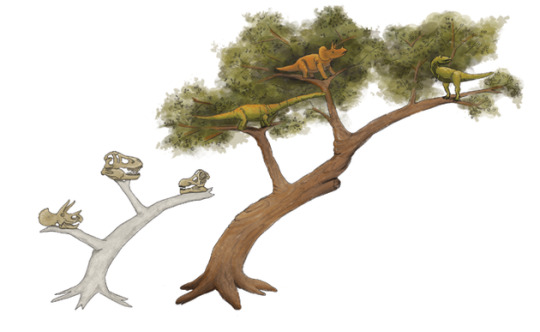
目前的恐龍演化樹從1887年開始使用,基本上是基於骨盆形態的差異。最近,科學家對這一分類方式的基礎提出了新的觀點
是什麼特徵讓一種恐龍區別於另一種恐龍?這個問題可能會讓很多人聯想到霸王龍巨大的下顎、角龍和劍龍身上獨特的角和板,以及蜥腳類恐龍及其近親的超大身軀。但對於古生物學家來說,要對不同的恐龍進行分類,關鍵在於這些動物的骨骼形態。
有了恐龍骨骼的形態學特徵和足夠的化石骨架知識,古生物學家可以大致確定恐龍標本在恐龍家族樹上的位置。然後,通過觀察其他特徵,特別是恐龍亞群共有的特徵,他們可以更詳細地找出這種動物的確切歸屬。
我們今天使用的恐龍分類系統首次發表於1887年。在研究了構成恐龍臀部的骨頭的朝向後,古生物學家哈里·西利(Harry Seeley)提出,根據骨盆的結構,所有的恐龍都可以歸為兩類。與所有四足動物一樣,恐龍骨盆由三塊骨頭組成:髂骨、坐骨和恥骨。西利發現,在某些物種,比如蜥腳類恐龍中,恥骨指向身體的前部,而對於其他物種,比如鴨嘴龍,恥骨則指向背部,與坐骨平行。西利將前一類恐龍稱為“蜥臀目”(Saurischia),因為這些動物的髖骨方向與蜥蜴的相似;後一類恐龍則被稱為“鳥臀目”(Ornithischia),因為它們的臀部結構與現代鳥類相似。在西利的分類中,這兩大分支中演化出了更特化的恐龍群體,包括演化出暴龍、馳龍和鳥類等類群的獸腳亞目恐龍。
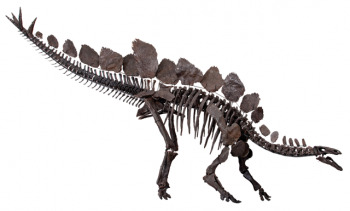
這張劍龍骨架圖顯示了其骨盆的後向恥骨。劍龍屬於鳥臀目,因為它們的骨盆結構與現代鳥類相似
從西利的時代開始,恐龍研究人員就一直把蜥臀目恐龍和鳥臀目恐龍區分開來。但是,在《自然》(Nature)雜誌2017年的一項研究中,由英國劍橋大學古生物學家馬修·巴倫(Matthew Baron)領導的團隊提出了對這種分類的徹底重組。巴倫和他的團隊建議,應該把鳥臀目和蜥臀目分類放在一邊,採用一種修正過的演化樹——對臀部骨骼結構的二分法並不能包含一切。這個新的分類把獸腳亞目恐龍和鳥臀目恐龍歸為一個新的類群,稱為“鳥腿目”(Ornithoscelida),而蜥腳類恐龍和艾雷拉龍(herrerasaurids)——在三疊紀滅絕的早期肉食性恐龍——仍然屬於蜥臀目(嚴格來說是蜥腳亞目)。
這樣的重組涉及恐龍演化樹底部附近的分支,代表著一次重大的改革,並且挑戰了建立在大約一個半世紀前研究基礎上的正統學說。新的分類有許多意義,比如表明肉食性恐龍獨立演化了至少兩次,分別是艾雷拉龍和獸腳亞目恐龍。由於這兩個群體之前都被認為是蜥臀目,因此傳統觀點認為,肉食性恐龍似乎只進化過一次。此外,羽毛曾經被認為存在於多種恐龍譜系中,但現在似乎只出現在獸腳亞目恐龍身上,而鳥類正是從獸腳亞目恐龍演化而來。此外,在長期使用的哈里·西利的演化樹中,我們並不清楚所有恐龍的最後共同祖先是蜥臀類還是鳥臀類,也不清楚從一種構造到另一種構造的演化過程可能發生了多少次。新的演化樹意味著,最早的恐龍具有似蜥蜴骨盆,而似鳥類骨盆的形態後來在多個“鳥腿目”支系中演化出來,特別是在鳥臀目和幾個獸腳亞目恐龍類群中。
然而,許多古生物學家並不准備接受這一經過修改的演化樹;這是一個艱難的命題,意味著我們對恐龍演化史的理解發生了巨大轉變。一些研究人員呼籲,我們應該謹慎行事,進行更多的研究。
一切都與骨骼有關

左邊是傳統的恐龍演化樹,根據骨盆形態的差異,將鳥臀目和蜥臀目分開。右邊是馬修·巴倫及其同事提出的新演化樹,其中鳥臀目與獸腳亞目形成了一個新的類群,叫做“鳥腿目”(Ornithoscelida
區分恐龍群體的關鍵是解剖數據,尤其是與骨骼相關的數據。然而,這些數據可能在某種程度上有些主觀,因此定義起來並不容易。當古生物學家試圖區分某一種恐龍或某個恐龍類群時,他需要藉助其他骨骼形態學的差異記錄。如果有足夠多的差異被記錄下來,就能描繪出關於恐龍如何演化出不同物種的畫面——從演化枝層面一直到單個物種。
從廣義上講,恐���作為一個整體與其他爬行動物類群(如翼龍)的區別在於,它們的髖臼窩上有一個洞。雖然髖骨一直是研究的重點,但也有許多其他骨骼需要考慮,例如股骨和牙齒。雖然像迷惑龍(Apatosaurus)這樣的蜥腳類恐龍有相對直的股骨,類似於支撐古希臘神廟的柱子,但像暴龍這樣的獸腳亞目恐龍的股骨則更多地呈弓形。與此同時,蜥腳類動物的牙齒形態也有所不同:一些具有鏟狀的牙齒,而另一些的牙齒則更像釘子。
這基本上就是巴倫和他的團隊在2017年的研究中所做的工作。他們建立了一個他們認為最能區分恐龍的形態學特徵數據集,包括顱骨上獨特的開口,以及不同肢體骨骼的形狀差異。他們總共觀察了74個不同恐龍類群的457個特徵,其中大部分數據來自之前發表的科學文獻。巴倫解釋稱,儘管他們並沒有打算從根本上重建恐龍的演化樹,但分析的結果使他們做到了這一點。
複雜的演化樹基礎
當你越接近恐龍演化樹的底部,也就是主要類群分化的地方,通過分析特徵來區分恐龍物種的做法就越棘手。已知的早期物種都有相似之處,古生物學家往往很難分辨誰是誰。這也是爭議的根源。對於巴倫團隊修改的恐龍演化樹,蘇格蘭愛丁堡大學的脊椎動物古生物學家史蒂夫·布魯薩特(Steve Brusatte)表示,這些早期的恐龍物種——稱為“恐龍形態類”(dinosauromorph) ——是解密恐龍演化樹基礎的關鍵。
在恐龍形態類中,一個基礎物種是晚三疊紀的月亮谷始盜龍(Eoraptor lunensis)。該物種的化石發現於阿根廷西北部的月亮谷,是一具近乎完整的骨架。始盜龍是一種兩足恐龍,生活在2.3億年前的岡瓦納超級大陸上。它的大小和狗差不多,生活在恐龍成為陸地頂級掠食者之前,後來才演化出今天我們所知的許多著名恐龍物種。

月亮谷始盜龍是一種早期恐龍,它可能是解決目前關於恐龍演化樹爭論的關鍵
巴倫表示,月亮谷始盜龍的前肢似乎適合抓握,而且它看起來是“完美、標準的基礎恐龍物種”。因為從形態上��,它可能是幾乎任何恐龍的祖先——這在確定哪些恐龍可能是它的直系後代時是個問題。巴倫說:“始盜龍就像是一場噩夢……”關於始盜龍到底是什麼,目前還眾說紛紜。
巴倫和他的同事認為,始盜龍適合抓握的前肢類似於後來獸腳亞目恐龍的前肢。其他研究人員,包括在20世紀90年代協助發現月亮谷始盜龍的芝加哥大學古生物學家保羅·塞里諾(Paul Sereno),根據拇指骨骼等特徵,認為它是蜥腳形亞目(Sauropodomorpha)的一員。蜥腳形亞目被認為是蜥腳類恐龍的祖先。塞里諾指出,月亮谷始盜龍的拇指骨頭彎曲,拇指的一側與地面接觸,這是後來蜥腳類恐龍的顯著特徵之一。
1961年,在南非侏羅紀早期的岩石中發現了另一種早期恐龍,塔克畸齒龍(Heterodontosaurus tucki)。古生物學家根據似鳥骨盆等特徵將其歸類為鳥臀目恐龍。然而,2017年新演化樹論文的共同作者、倫敦自然史博物館的恐龍專家保羅·巴雷特(Paul Barrett)表示,塔克畸齒龍“具有許多只有肉食性獸腳亞目恐龍才有的特徵”。塔克畸齒龍與獸腳亞目恐龍的相似特徵包括細長的肩胛骨、臀部前方用於肌肉附著的突出部分,以及像月亮谷始盜龍那樣適合抓握的前肢。這些共同點使巴倫、巴雷特和他們的同事第一次意識到,恐龍演化樹“發生了一些更加複雜的事情”。
巴雷特表示,塔克畸齒龍“是一種鳥臀目恐龍”,但基於新提出的恐龍演化樹,它似乎比原先想像的更接近獸腳亞目恐龍。
這些早期恐龍生活在演化樹的底部,對上層結構有著重要的意義。但是,早期恐龍的身份還存在著很多不確定性:它們是什麼?它們與後來的哪些恐龍關係最密切?這些都意味著它們在演化樹上的位置尚未確定。布魯薩特表示,這些早期恐龍“在演化樹上到處移動”,取決於你向誰提問。 “這些奇怪的物種中有一些具有不同群體的特徵組合。它們會造成麻煩,但也能讓我們看得更清楚。它們可以把不同類群聯繫起來,”他說道。
最重要的決定因素
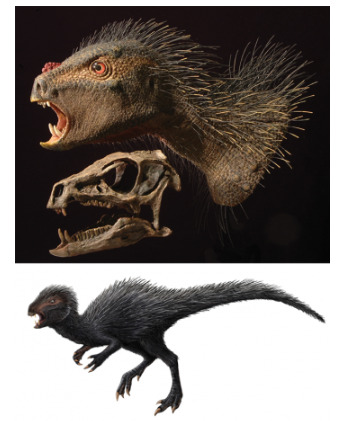
和始盜龍一樣,塔克畸齒龍也是近幾十年來發現的早期恐龍之一。這些新發現促使一些古生物學家重新思考恐龍的分類
不過,在做出任何定義之前,科學家必須就各種形態特徵(如拇指形狀)的重要性或相關程度達成一致意見,以便解釋不同物種之間的關係。這些特徵應該如何評估呢?塞里諾指出,這種評估十分主觀。
塞里諾表示,目前恐龍古生物學家整合和使用數據集的方式,以及他們建立演化樹的方式,都需要改變。他說:“你可以提出一個假說,然後忽略其他人以往觀察同一類群時所用的很大一部分數據。”
例如,當研究人員評估骨骼形態時,他們可能會將骨骼的某個特定部分描述為圓形或方形,這取決於研究人員自己。此外,如果某個研究者不能判斷形態學是圓的還是正方形的,他們可能會簡單地標註這個特徵“不存在”。但是,塞里諾解釋稱,“缺失”或“存在”與形態——感興趣的特徵——無關,因此將形狀描述為“缺失”掩蓋了該特徵在解釋演化關係方面的意義或相關性。
塞里諾認為,恐龍特徵的評估和數據集的使用都需要標準化,這是解決研究人員主觀性問題的唯一方法,“我們需要更多的規則”。
這些新規則將如何形成尚不清楚,但在標準化之前,當不同的研究人員進行分析時,將繼續出現不同的結果和不同的演化樹。例如,在2017年修改恐龍演化樹的提議之後,布魯薩特及其合作者研究了巴倫團隊使用的同一組特徵。他們仔細分析了研究中涉及的每一種形態特徵,並根據自己的專業知識對它們進行了重新解釋。最後,他們提出了支持傳統鳥臀目和蜥臀目分類的演化樹。布魯薩特說,主觀性就是“這場‘遊戲’的本質”。
古生物學的很多內容都來自主觀的描述和假設,比如始盜龍的“抓握前肢”與後來的獸腳亞目恐龍或蜥腳類恐龍之間到底有多大的相似性古生物學的很多內容都來自主觀的描述和假設,比如始盜龍的“抓握前肢”與後來的獸腳亞目恐龍或蜥腳類恐龍之間到底有多大的相似性
不過,這場爭論所有的參與者似乎都同意,“我們真的需要更多的化石,尤其是來自恐龍演化樹底部附近的三疊紀恐龍新化石,這些化石有助於理清這些支系之間的關係,”布魯薩特說,“(這場爭論)揭示出,我們以往認為的定論實際上還是一個謎,而這個謎必須被解開。”
巴倫表示同意:“可能是兩三個發現造成了所有的不同。”
目前,我們還不清楚哪種版本的恐龍演化樹——傳統的還是修正的——更接近真相。與此同時,為了克服意見上的分歧,古生物學家需要建立一套用於分析化石的標準指標,“我們需要更多的合作,”巴倫說。 (任天)
.
from 重新定義恐龍:是什麼特徵讓一種恐龍區別於另一種?
via KKNEWS
0 notes